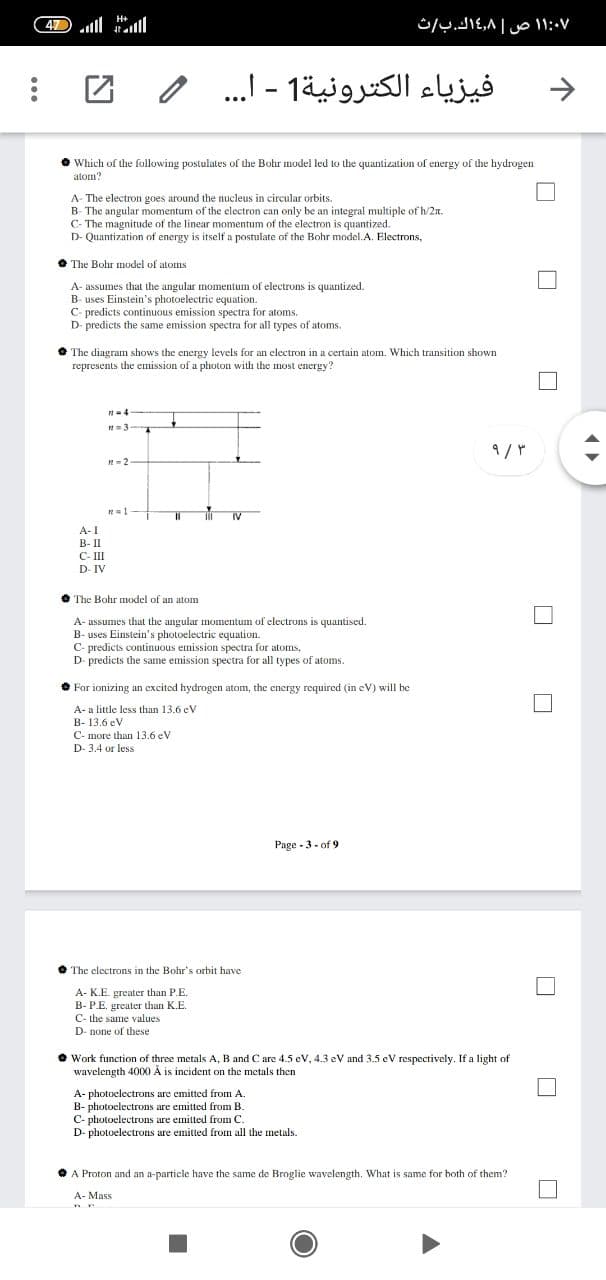• Which of the following postulates of the Bohr model led to the quantization of energy of the hydrogen atom? A- The electron goes around the nucleus in circular orbits. B- The angular momentum of the electron can only be an integral multiple of h/2a. C- The magnitude of the linear momentum of the electron is quantized. D- Quantization of energy is itself a postulate of the Bohr model.A. Electrons, • The Bohr model of atoms A- assumes that the angular momentum of electrons is quantized. B- uses Einstein's photoelectric equation. C- predicts continuous emission spectra for atoms. D- predicts the same emission spectra for all types of atoms. • The diagram shows the energy levels for an electron in a certain atom. Which transition shown represents the emission of a photon with the most energy? R= 2 =1- %3D IV A-I A-I В-П C- III D- IV • The Bohr model of an atom A- assumes that the angular momentum of electrons is quantised. B- uses Einstein's photoelectric equation. C- predicts continuous emission spectra for atoms, D- predicts the same emission spectra for all types of atoms. • For ionizing an excited hydrogen atom, the energy required (in eV) will be A- a little less than 13.6 cV B- 13.6 eV C- more than 13.6 eV D- 3.4 or less Page - 3- of 9 O The electrons in the Bohr's orbit have A- K.E. greater than P.E. B- P.E. greater than K.E. C- the same values D- none of these • Work function of three metals A, B and C are 4.5 eV, 4.3 eV and 3.5 eV respectively. If a light of wavelength 4000 À is incident on the metals then A- photoclectrons are emitted from A. B- photoelectrons are emitted from B. C- photoelectrons are emitted from C. D- photoelectrons are emitted from all the metals.
Quantum mechanics and hydrogen atom
Consider an electron of mass m moves with the velocity v in a hydrogen atom. If an electron is at a distance r from the proton, then the potential energy function of the electron can be written as follows:
Isotopes of Hydrogen Atoms
To understand isotopes, it's easiest to learn the simplest system. Hydrogen, the most basic nucleus, has received a great deal of attention. Several of the results seen in more complex nuclei can be seen in hydrogen isotopes. An isotope is a nucleus of the same atomic number (Z) but a different atomic mass number (A). The number of neutrons present in the nucleus varies with respect to the isotope.
Mass of Hydrogen Atom
Hydrogen is one of the most fundamental elements on Earth which is colorless, odorless, and a flammable chemical substance. The representation of hydrogen in the periodic table is H. It is mostly found as a diatomic molecule as water H2O on earth. It is also known to be the lightest element and takes its place on Earth up to 0.14 %. There are three isotopes of hydrogen- protium, deuterium, and tritium. There is a huge abundance of Hydrogen molecules on the earth's surface. The hydrogen isotope tritium has its half-life equal to 12.32 years, through beta decay. In physics, the study of Hydrogen is fundamental.

Step by step
Solved in 4 steps








